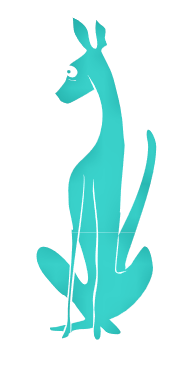
The dog's amazing nose in detail.
The Dog's Amazing Nose!
The Olfactory Bulb is a bulb of neural tissue within the dog’s brain. It is located in the fore-brain and is responsible for processing scents detected by cells in the nasal cavity. It is approximately 40 times larger in dogs than in humans, relative to total brain size. A humans brain is dominated by a large visual cortex whilst a dog’s brain is dominated by the olfactory cortex. The Olfactory bulb accounts for one eighth of the dog’s brain.
The Olfactory bulb is extremely important to the dog due to its function of processing scent. Scent information travels from the Olfactory bulb to the limbic system which is the most primitive part of the brain (dealing with emotions, memory and behaviour). It also travels to the cortex (The cortex is the outer part of the brain that has to do with conscious thought). In addition to these two areas, information also travels to the taste sensory cortex to create the sense of flavour. Because olfactory information goes to both the primitive and complex part of the brain it effects the dog’s actions in more ways than we may think.
A dog’s sense of smell is probably more important to it than any other sense with the possible exception of touch (in a well-adjusted dog), the sense of smell and the sense of touch are the predominant senses for a dog and they are in place and fully functioning at birth, unlike hearing and sight, which develop later, and taste which although present at birth and connected to smell takes a back seat.
A dog has around 220 million scent receptors in his nose – that’s 44 times the number of receptors in our own human nose. The bloodhound exceeds this standard with nearly 300 million scent receptors!
The dog’s amazing scenting ability enables him to detect prey and helps him discern a females place in her sexual cycle. Each dog emits a personal olfactory profile that imparts a wealth of information to other dogs. The act of marking deposits information about the dog including age, sex, mood, health status, diet, size of pack and rank. A well socialised dog will engage in mutual sniffing with another dog as a polite greeting. A dog can smell adrenaline and pheromones that we cannot; they can therefore anticipate a fight or flight response from a person or animal before we have a clue. Although it should be noted – a dog cannot rationalise and distinguish why a person is kicking out great clouds of adrenaline in their presence. It may be that the human is scared stiff of dogs, but the dog won’t know this, only that this person is gearing up to fight or flee and should be carefully watched for any sign of an attack. So the Olfactory bulb is indispensable to a dog, it informs and it forewarns. It also allows the dog to assist us with specific jobs; the dog’s olfactory system is more sensitive than anything we can replicate with modern technology.
Dogs have been found to have high success rates at detecting cancer in humans through smell, they can sniff out drugs and explosives in busy airports for us - even if the object in question has been over-scented with something strong smelling they can separate the different scents, they can discern the direction of a target by sniffing and noting where the scent is marginally stronger in order to establish the ‘way the scent went’ for tracking purposes. They have mobile noses that can distinguish scent direction on the wind, moisture on the nose helps with this function.
They are truly brilliant where scent is concerned and the Olfactory bulb is the centre of this skill.
It is common knowledge that short snouted breeds of dog often show an impaired sense of smell and that all the dogs commonly used for scenting purposes are of the long snouted variety. Recently a study conducted by Michael Valenzuela of the University of New South Wales in Australia investigated the position of the brain within the skull to determine whether selectively breeding for differences in skull length between dog breeds has also reorganized the canine brain. The dogs with the shortest skulls—such as the pit bull and Akita showed significant brain reorganization. It was found that when selective breeding by humans shortened the snouts of certain dog breeds, it also morphed their brains to compensate. The whole brain was shown to have rotated thus relocating the olfactory lobe towards the bottom of the skull. This has sacrificed the sensitivity of some breeds sense of smell somewhat and it is for this reason that bulldogs are no good at tracking!
A simple scent can have a host of complex meanings, memories and emotional ties for our dogs as scent is directly linked to both memory and emotion via the limbic system, smell memories last for life and we can use scent to elicit as positive emotion to assist in cases of fear and phobia.
